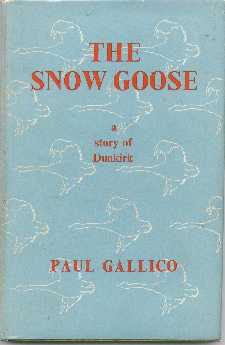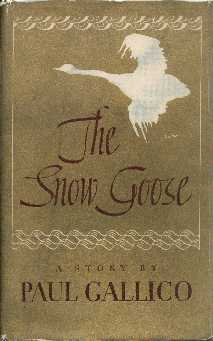

 |
 |
1941 - Michael Joseph
|
1941 - Knopf
|
Jenny Campbell - January 2001
The Snow Goose contains a complex web of human questions which are not limited to the period during which it was written. When it came out, it caused quite a topical sensation due to the Dunkirk element. Paul Gallico, as with Robert Louis Stevenson, had an almost uncanny ability to write books which could skilfully hold an audience of both children and adults. He seemed to be saying in the Snow Goose: in learning what is valuable in life, age and status are irrelevant. His sensitivity to the suffering of the poor, under-educated and displaced, the profound emotional life of those under social duress and the generosity of the uncorrupted human spirit take the reader to highs and lows as only a master of eloquence can. Compassion weaves its way gently through the book and can be found on every page. Phenomenon such as loyalty are treated, in the form of the Snow Goose herself, with reverence and gravity. The strength of her gratitude for being healed and fed led her to a yearly migration which defied her own migrational instincts. In this sense, the intelligence of animals is cleverly juxtaposed to the simplicity of loyalty. One suspects both were as fasinating as each other to Gallico. Without a hint of pretension, Love is embraced as the enigmatic element of humanness it is, his characters giving us more than a glimpse of the purity contained in a soul free of opportunism and prejudice. Put simply, the emotional journey of The Snow Goose is a cathartic metaphor for everything beautiful and noble within the human psyche.
These pages are copyright © Martin Benson 1999-2021. You are welcome to link to them.